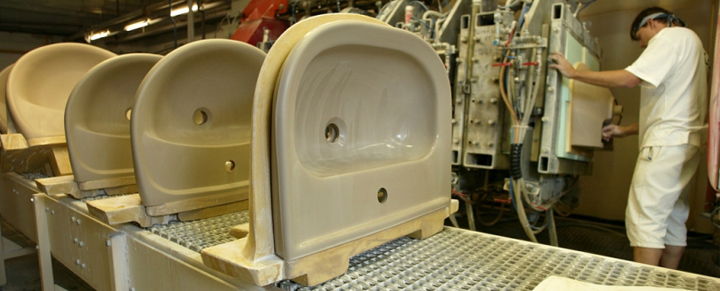
Making ceramics today, 140 years after we started
Extensive automation of the manufacturing process and our patented casting under pressure technology bring a new way of producing sanitary ceramics
Use of casting under pressure for sanitary ware production is a patented manufacturing technology, being used since 1985. In order to develop JIKA ceramic designs, nine lines equipped with such technology operate in the Czech Republic. At the moment one works in Znojmo manufacturing washbasins, and eight other lines stand in Bechyně, delivering cisterns, toilets, and washbasins.
Casting under pressure is based on the use moulds made of porous plastic; these consist of two to four parts, depending on the complexity and shape of the final product. One mould may be used to make 35 to 40 thousand products, and therefore it can last much longer than an alternative plaster mould, which must be replaced after every 90 to 100 castings.
At first, a mould for casting under pressure is pre-filled with the casting slip with the temperature of 40 to 43 deg. Celsius (the so-called DITURVIT) under the pressure of 3 to 4 bars; the pressure is raised to 10 to 12 bars when the filling is completed. Casting slip, which is a mixture of water, clay, kaolin, feldspar, silica sand, and an additive of finely ground pieces of ceramic scrap, starts to form into a ceramic body. By applying the pressure, material adheres to the surface of the mould, while water drains away through porous walls of the mould. After producing a ceramic body 9.0 to 9.7 mm thick, excess casting slip in the mould is drained away, letting the moulded piece solidify under the pressure of 2.5 bars. Moulded piece is then removed, dressed (holes are made, excess material is cut off), and pre-dried in the microwave kiln. After pre-drying, the moulded piece is again dressed, checked for flaws, and final dried, so that it could be glazed and baked.
As a direct result of this and further technological implementations, sanitary ceramics by JIKA boast noticeable benefits at usage. Specifically, cleaning easiness, along perfectly glazed surfaces of inner rings and siphon traps mean minimal dirt deposition. Resistance to marked thermal variation, scratching, and color stability despite the passing of time come up among the aesthetic pros. In a breakthrough, our recently marketed surface treatment JIKA perla allows exceptional hygiene with its water repellent features, equaling dirt and scale-free external surfaces on the ceramic pieces.

